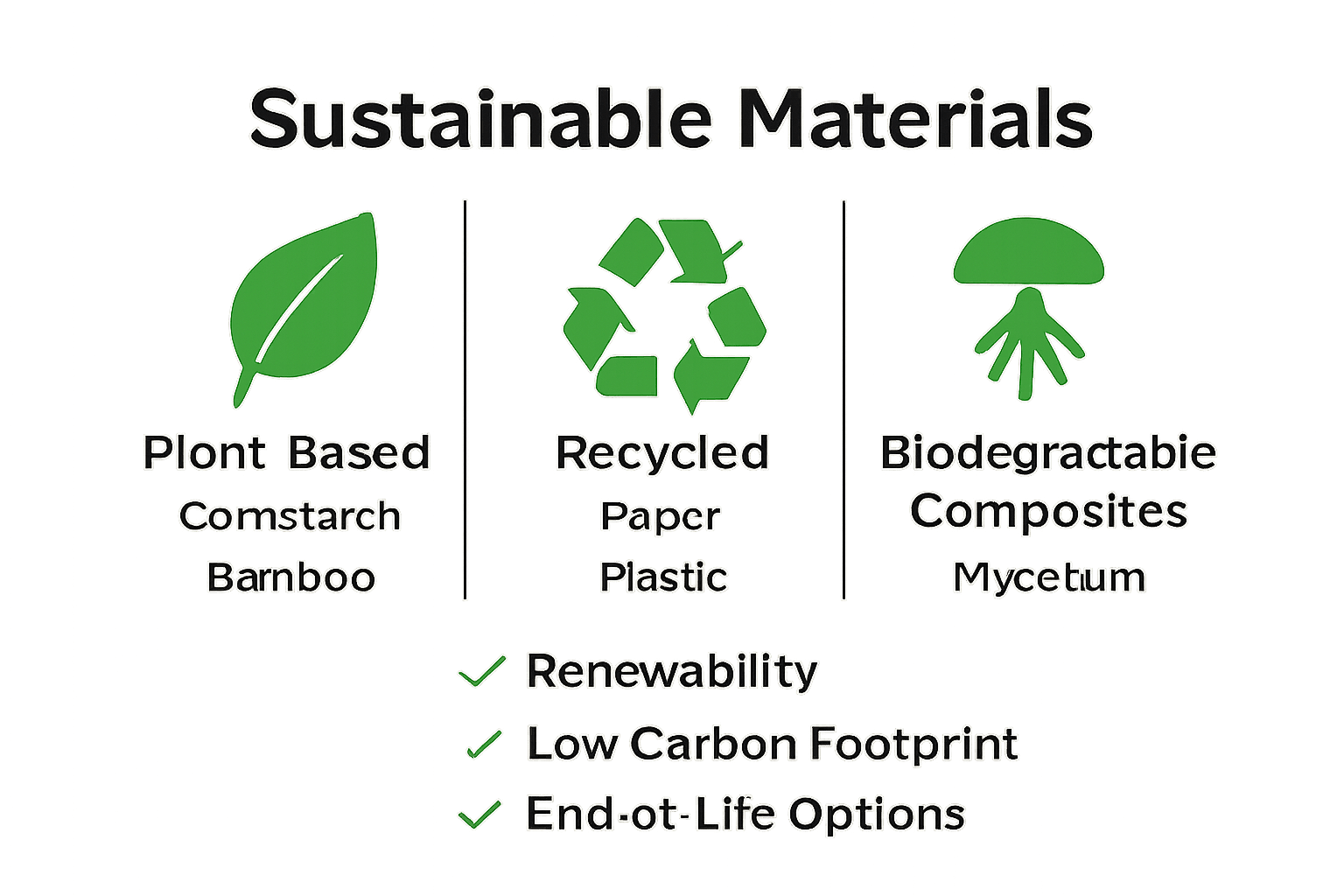Your Cart is Empty
Free Standard Shipping for Contiguous U.S. Orders!
Free Standard Shipping for Contiguous U.S. Orders!
Catalog

What Are Sustainable Products? Complete Guide
November 14, 2025 6 min read
Nearly 60 percent of global consumers say they are willing to pay more for sustainable products. This shift reflects a growing awareness of how everyday purchases impact the planet. Understanding what truly makes a product sustainable can help shoppers avoid greenwashing and make smarter choices that protect both the environment and their communities. Discover how key concepts and materials shape the future of eco-friendly living and responsible consumption.
Table of Contents
- Defining Sustainable Products and Key Concepts
- Types of Sustainable Products by Material and Use
- Essential Features of Sustainable Goods
- Environmental and Economic Impact Considerations
- How to Choose Authentic Sustainable Products
Key Takeaways
| Point | Details |
|---|---|
| Understanding Sustainable Products | Sustainable products aim to minimize ecological impact across their lifecycle, emphasizing ethical production and the use of renewable materials. |
| Material Categories | Key sustainable materials include plant-based, recycled, and biodegradable composites, offering eco-friendly options for various applications. |
| Impact on Consumption | Sustainable products support reduced carbon footprints and promote circular economy principles, leading to long-term economic and environmental benefits. |
| Choosing Authenticity | To select true sustainable products, verify certifications, examine product lifecycles, and research brand transparency for informed decision-making. |
Defining Sustainable Products and Key Concepts
Sustainable products represent a critical approach to addressing environmental challenges through conscious consumption and production practices. According to Wikipedia, these products are “sustainably sourced, manufactured, or processed, providing environmental, social, and economic benefits while protecting public health and the environment throughout their entire life cycle.”
Understanding sustainable products involves recognizing their comprehensive impact beyond traditional manufacturing. University of South Carolina research highlights that defining such products is inherently complex, as all products inevitably generate some environmental impact. The key distinction lies in minimizing negative ecological consequences across a product’s entire lifecycle.
Key characteristics of sustainable products typically include:
- Minimal environmental footprint
- Ethical production processes
- Use of renewable or recycled materials
- Energy efficiency during manufacturing and usage
- Potential for recycling or responsible disposal
For eco-conscious consumers interested in deeper exploration, our guide on understanding sustainable home products offers additional insights into making environmentally responsible purchasing decisions. By prioritizing products designed with holistic sustainability principles, individuals can contribute meaningfully to global environmental conservation efforts.
Types of Sustainable Products by Material and Use
Sustainable products encompass a wide range of materials and applications, each designed to minimize environmental impact while meeting practical consumer needs. Wikipedia highlights biocomposites as innovative materials formed by combining natural fiber reinforcements with renewable resins, creating products that are recyclable and biodegradable across industries like automotive, construction, and packaging.
The world of sustainable materials continues to expand through biodesign approaches. According to Wikipedia, cutting-edge sustainable products now integrate living systems and organic materials, utilizing fascinating components like:
- Mycelium (fungal-based materials)
- Bacterial cellulose
- Algae-based polymers
These innovative materials enable the creation of sustainable products across multiple categories. For example, in home organization, reasons to choose bamboo for sustainability demonstrate how natural materials can provide both ecological benefits and functional design. Sustainable products can be categorized into several key material types:

- Plant-Based Materials
- Bamboo
- Cork
- Hemp
- Organic cotton
- Recycled Materials
- Reclaimed plastics
- Recycled metals
- Repurposed wood
- Upcycled textiles
- Biodegradable Composites
- Mycelium packaging
- Algae-derived plastics
- Agricultural waste composites
- Biodegradable polymers
By embracing these diverse sustainable materials, consumers can make environmentally responsible choices that reduce ecological footprints while supporting innovative product development.

Essential Features of Sustainable Goods
Sustainable goods represent a holistic approach to product design and consumption that goes far beyond traditional manufacturing practices. Wikipedia identifies key characteristics that distinguish truly sustainable products, including a dual focus on ecological and social significance, customer satisfaction, and a comprehensive life-cycle orientation.
Transparency plays a crucial role in sustainable product development. Wikipedia introduces the Environmental Product Declaration (EPD), a critical tool that quantifies environmental information throughout a product’s lifecycle. This declaration enables consumers to make informed comparisons between products serving similar functions, empowering more conscious purchasing decisions.
Essential features of sustainable goods typically include:
- Minimal environmental impact
- Ethical and fair production processes
- Use of renewable or recycled materials
- Energy efficiency
- Potential for recycling or responsible disposal
- Transparent supply chain
- Long-term durability
For those interested in practical applications of sustainable design, why choose bamboo home products provides insights into how natural materials can create environmentally responsible and functional solutions. By prioritizing these essential features, consumers and manufacturers can work together to reduce ecological footprints and support more sustainable global production practices.
Environmental and Economic Impact Considerations
Sustainable products represent a complex intersection of environmental preservation and economic innovation. ArXiv highlights groundbreaking research in bioplastics development, demonstrating how scientific advancements can create scalable, water-based processes for producing biodegradable materials that offer significant environmental advantages over traditional plastic production.
ArXiv research reveals another critical dimension of sustainable product development: value-sensitive design. This approach empowers consumers by providing transparent product information and explainable ratings, ultimately driving a collective shift towards more sustainable consumption patterns. The economic implications are profound, as consumers increasingly make purchasing decisions based on environmental consciousness.
Key environmental and economic considerations for sustainable products include:
- Reduced carbon footprint
- Lower waste generation
- Resource conservation
- Support for circular economy models
- Long-term cost savings
- Creation of green job opportunities
- Reduced environmental remediation expenses
For consumers seeking practical insights into sustainable choices, why choose bamboo home products offers a compelling exploration of how individual purchasing decisions can contribute to broader environmental and economic sustainability goals. By understanding these multifaceted impacts, individuals and businesses can make more informed, responsible choices that benefit both the planet and economic systems.
How to Choose Authentic Sustainable Products
Choosing authentic sustainable products requires a thoughtful and strategic approach that goes beyond surface-level marketing claims. Wikipedia defines sustainable consumer behavior as a comprehensive process involving careful product selection, consumption, and disposal while understanding the broader environmental and social implications of each purchase.
ArXiv research highlights innovative solutions like personal shopping assistants that support value-sensitive design, providing consumers with transparent product information to make more informed, sustainable choices. This technological approach empowers individuals to navigate the complex landscape of sustainable products more effectively.
Key strategies for selecting authentic sustainable products include:
- Verify Certifications
- Look for recognized sustainability labels
- Check third-party environmental certifications
- Research the credibility of claimed sustainability standards
- Examine Product Lifecycle
- Investigate raw material sourcing
- Assess manufacturing processes
- Consider end-of-life disposal options
- Research Brand Transparency
- Review company sustainability reports
- Understand corporate environmental commitments
- Evaluate supply chain practices
For practical guidance on making sustainable choices, 10 sustainable examples of bamboo products offers insights into selecting eco-friendly alternatives that align with sustainable living principles. By approaching product selection with critical thinking and informed research, consumers can make meaningful contributions to environmental conservation and responsible consumption.
Embrace True Sustainability with Stylish Bamboo Solutions
The article highlights the challenges of finding authentic sustainable products that minimize environmental impact throughout their lifecycle while maintaining functionality and aesthetic appeal. If you want to overcome issues like unclear certifications and opaque supply chains while choosing eco-friendly options, focusing on materials like bamboo is a proven strategy. Bamboo is naturally renewable, biodegradable, and energy efficient — matching key elements of sustainable products discussed in the guide.

Explore premium handcrafted bamboo items at Cozee Bay, where eco-conscious consumers discover durable, stylish, and responsibly made solutions for home and commercial spaces. From bamboo paper towel dispensers to food bag organizers, every piece exemplifies transparency and environmental care. Make a positive impact with products designed to reduce waste and support a circular economy. Visit Cozee Bay today to shop thoughtfully and enjoy free shipping within the contiguous U.S.
Frequently Asked Questions
What are sustainable products?
Sustainable products are goods that are sourced, manufactured, or processed with a focus on providing environmental, social, and economic benefits while minimizing negative impacts throughout their lifecycle.
What materials are commonly used in sustainable products?
Common materials used in sustainable products include plant-based materials like bamboo and organic cotton, recycled materials such as reclaimed plastics and upcycled textiles, and biodegradable composites like mycelium packaging and algae-derived plastics.
How can I identify authentic sustainable products?
You can identify authentic sustainable products by verifying certifications from recognized sustainability labels, examining the product lifecycle from raw material sourcing to disposal, and researching brand transparency through sustainability reports and supply chain practices.
What are the environmental and economic benefits of using sustainable products?
Using sustainable products leads to reduced carbon footprints, lower waste generation, conservation of resources, support for circular economy models, long-term cost savings, creation of green jobs, and reduced environmental remediation expenses.
Recommended
Leave a comment
Comments will be approved before showing up.
Subscribe
Sign up to get the latest on sales, new releases and more …

